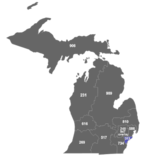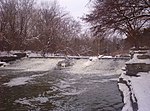The River Rouge is a 127-mile (204 kilometer) river in the Metro Detroit area of southeastern Michigan. It flows into the Detroit River at Zug Island, which is the boundary between the cities of River Rouge and Detroit.
The river's roughly 467-square-mile (1,210 km2) watershed includes all or parts of 48 municipalities, with a total population of more than 1.35 million, and it drains a large portion of central and northwest Wayne County, as well as much of southern Oakland County and a small area in eastern Washtenaw County. Nearly the entire drainage basin is in urban and suburban areas, with areas of intensive residential and industrial development. Still, more than 50 miles (80 km) of the River Rouge flow through public lands, making it one of the most accessible rivers in the state.
Until recently the river was heavily polluted, and in 1969 oil on the surface caught fire. The passage of the Clean Water Act in 1972 made it unlawful to discharge any pollution from a point source into navigable waters, and the EPA's National Pollution Discharge Elimination Program was created to regulate these discharges.
In 1986, a non-profit organization of concerned citizens called Friends of the Rouge was formed and began organizing an annual cleanup called Rouge Rescue, to raise awareness about the need to clean up the Rouge. In 1987, the entire watershed was designated a Great Lakes "area of concern" under the Great Lakes Water Quality Agreement.In 1992, a massive project called the Rouge River National Wet Weather Demonstration Project was implemented, and further cleanup measures are ongoing. The Alliance of Rouge Communities is an organization of governmental and non-governmental entities created in 2006 to manage the watershed.








